Corporate Governance and Financial Regulation - Desklib
VerifiedAdded on 2023/06/11
|12
|3297
|258
AI Summary
This report discusses two relevant corporate governance theories - Agency Theory and Stewardship Theory, stakeholder analysis of Tesco Plc, evaluation of the board structure of the company and institutional investors of the company. The report also provides insights into the interest level, claims, expectations, perceived conflicts and how the company manages the same. The report is relevant for students pursuing courses in corporate governance and financial regulation.
Contribute Materials
Your contribution can guide someone’s learning journey. Share your
documents today.
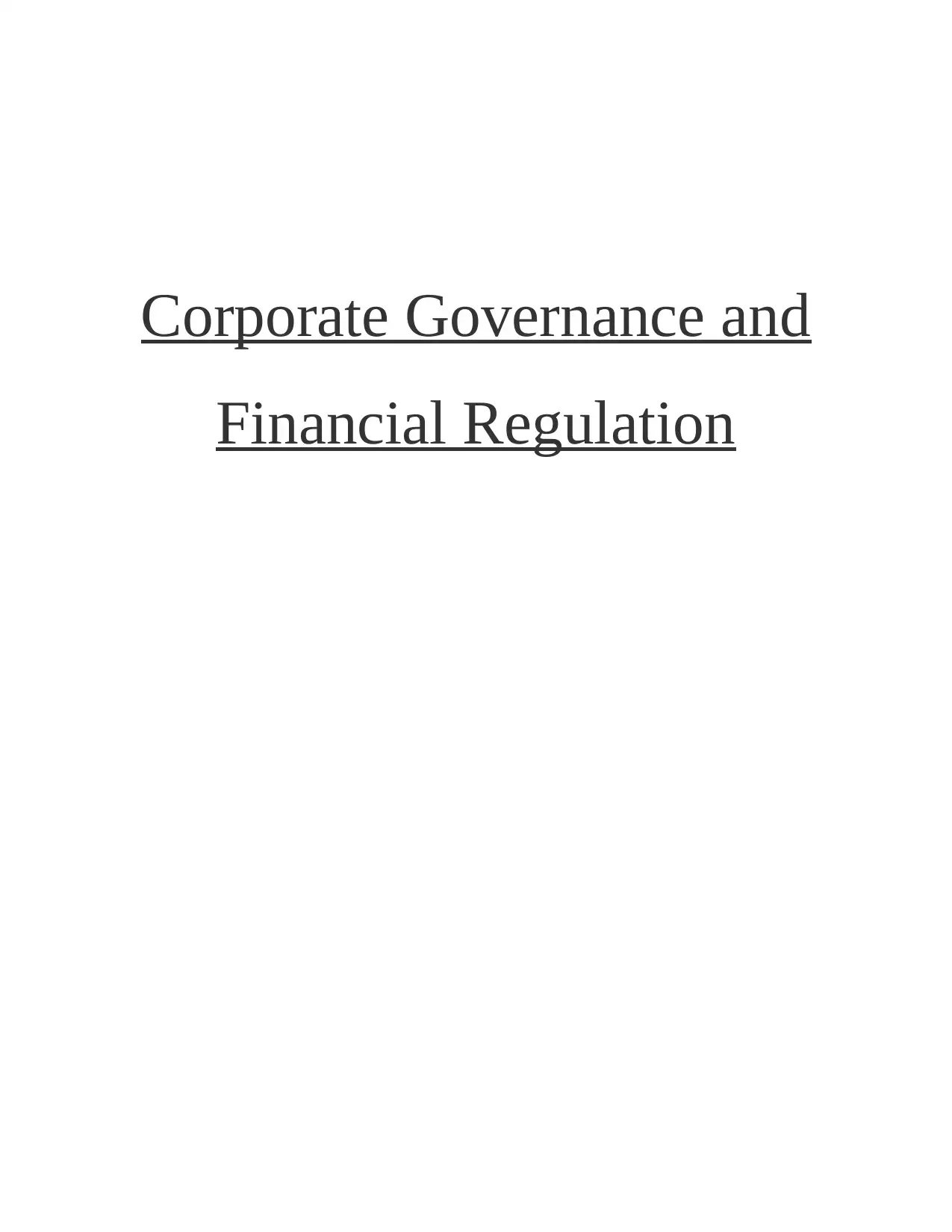
Corporate Governance and
Financial Regulation
Financial Regulation
Secure Best Marks with AI Grader
Need help grading? Try our AI Grader for instant feedback on your assignments.
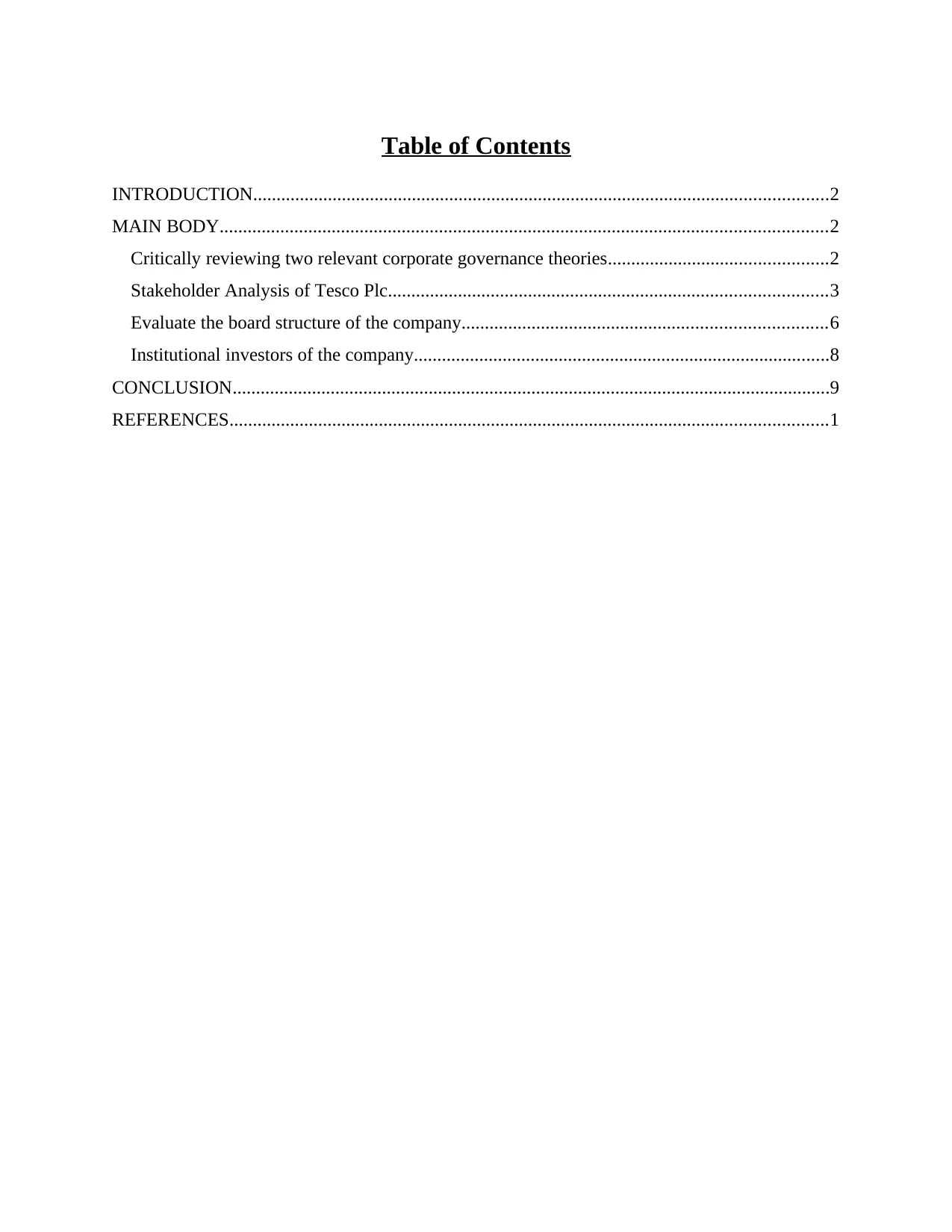
Table of Contents
INTRODUCTION...........................................................................................................................2
MAIN BODY..................................................................................................................................2
Critically reviewing two relevant corporate governance theories...............................................2
Stakeholder Analysis of Tesco Plc..............................................................................................3
Evaluate the board structure of the company..............................................................................6
Institutional investors of the company.........................................................................................8
CONCLUSION................................................................................................................................9
REFERENCES................................................................................................................................1
INTRODUCTION...........................................................................................................................2
MAIN BODY..................................................................................................................................2
Critically reviewing two relevant corporate governance theories...............................................2
Stakeholder Analysis of Tesco Plc..............................................................................................3
Evaluate the board structure of the company..............................................................................6
Institutional investors of the company.........................................................................................8
CONCLUSION................................................................................................................................9
REFERENCES................................................................................................................................1
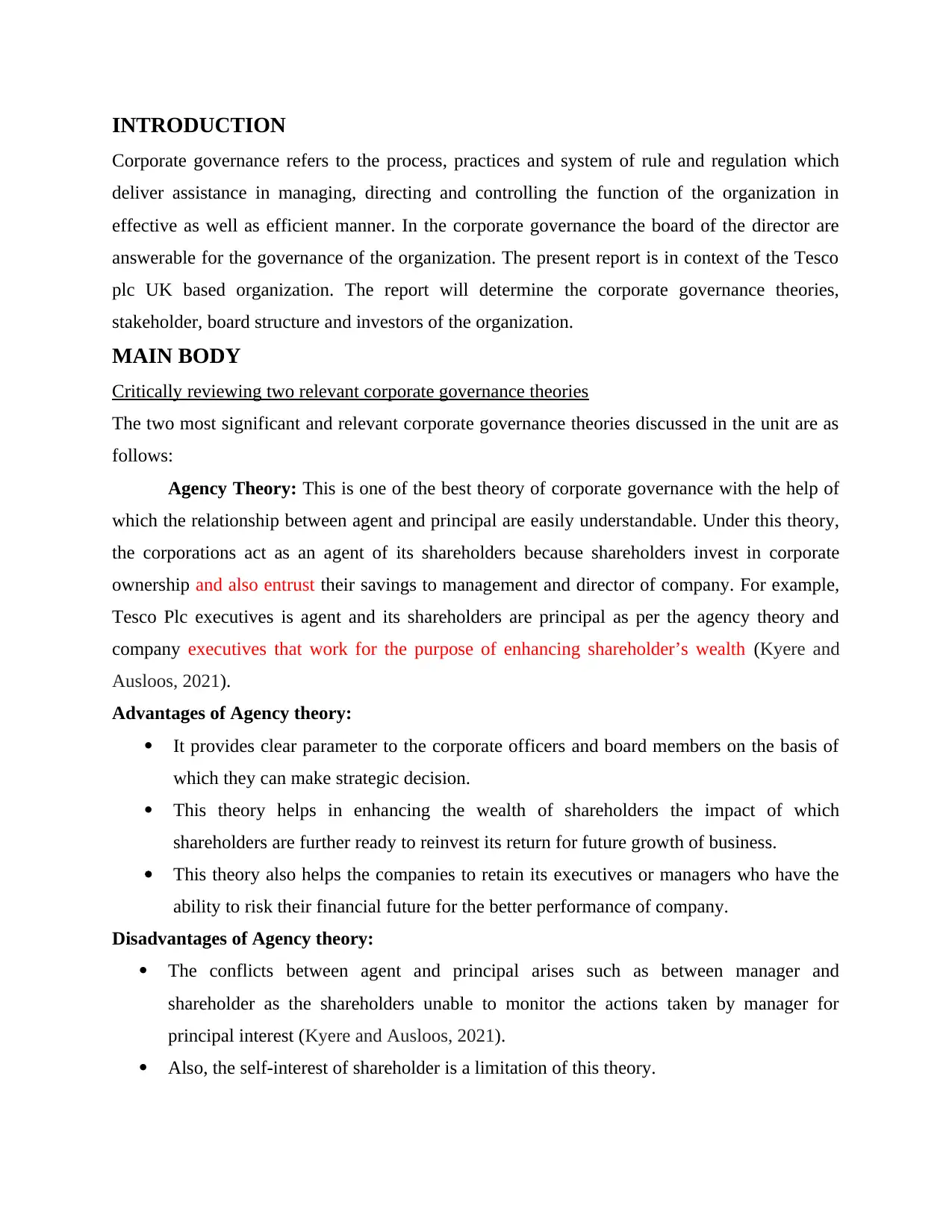
INTRODUCTION
Corporate governance refers to the process, practices and system of rule and regulation which
deliver assistance in managing, directing and controlling the function of the organization in
effective as well as efficient manner. In the corporate governance the board of the director are
answerable for the governance of the organization. The present report is in context of the Tesco
plc UK based organization. The report will determine the corporate governance theories,
stakeholder, board structure and investors of the organization.
MAIN BODY
Critically reviewing two relevant corporate governance theories
The two most significant and relevant corporate governance theories discussed in the unit are as
follows:
Agency Theory: This is one of the best theory of corporate governance with the help of
which the relationship between agent and principal are easily understandable. Under this theory,
the corporations act as an agent of its shareholders because shareholders invest in corporate
ownership and also entrust their savings to management and director of company. For example,
Tesco Plc executives is agent and its shareholders are principal as per the agency theory and
company executives that work for the purpose of enhancing shareholder’s wealth (Kyere and
Ausloos, 2021).
Advantages of Agency theory:
It provides clear parameter to the corporate officers and board members on the basis of
which they can make strategic decision.
This theory helps in enhancing the wealth of shareholders the impact of which
shareholders are further ready to reinvest its return for future growth of business.
This theory also helps the companies to retain its executives or managers who have the
ability to risk their financial future for the better performance of company.
Disadvantages of Agency theory:
The conflicts between agent and principal arises such as between manager and
shareholder as the shareholders unable to monitor the actions taken by manager for
principal interest (Kyere and Ausloos, 2021).
Also, the self-interest of shareholder is a limitation of this theory.
Corporate governance refers to the process, practices and system of rule and regulation which
deliver assistance in managing, directing and controlling the function of the organization in
effective as well as efficient manner. In the corporate governance the board of the director are
answerable for the governance of the organization. The present report is in context of the Tesco
plc UK based organization. The report will determine the corporate governance theories,
stakeholder, board structure and investors of the organization.
MAIN BODY
Critically reviewing two relevant corporate governance theories
The two most significant and relevant corporate governance theories discussed in the unit are as
follows:
Agency Theory: This is one of the best theory of corporate governance with the help of
which the relationship between agent and principal are easily understandable. Under this theory,
the corporations act as an agent of its shareholders because shareholders invest in corporate
ownership and also entrust their savings to management and director of company. For example,
Tesco Plc executives is agent and its shareholders are principal as per the agency theory and
company executives that work for the purpose of enhancing shareholder’s wealth (Kyere and
Ausloos, 2021).
Advantages of Agency theory:
It provides clear parameter to the corporate officers and board members on the basis of
which they can make strategic decision.
This theory helps in enhancing the wealth of shareholders the impact of which
shareholders are further ready to reinvest its return for future growth of business.
This theory also helps the companies to retain its executives or managers who have the
ability to risk their financial future for the better performance of company.
Disadvantages of Agency theory:
The conflicts between agent and principal arises such as between manager and
shareholder as the shareholders unable to monitor the actions taken by manager for
principal interest (Kyere and Ausloos, 2021).
Also, the self-interest of shareholder is a limitation of this theory.
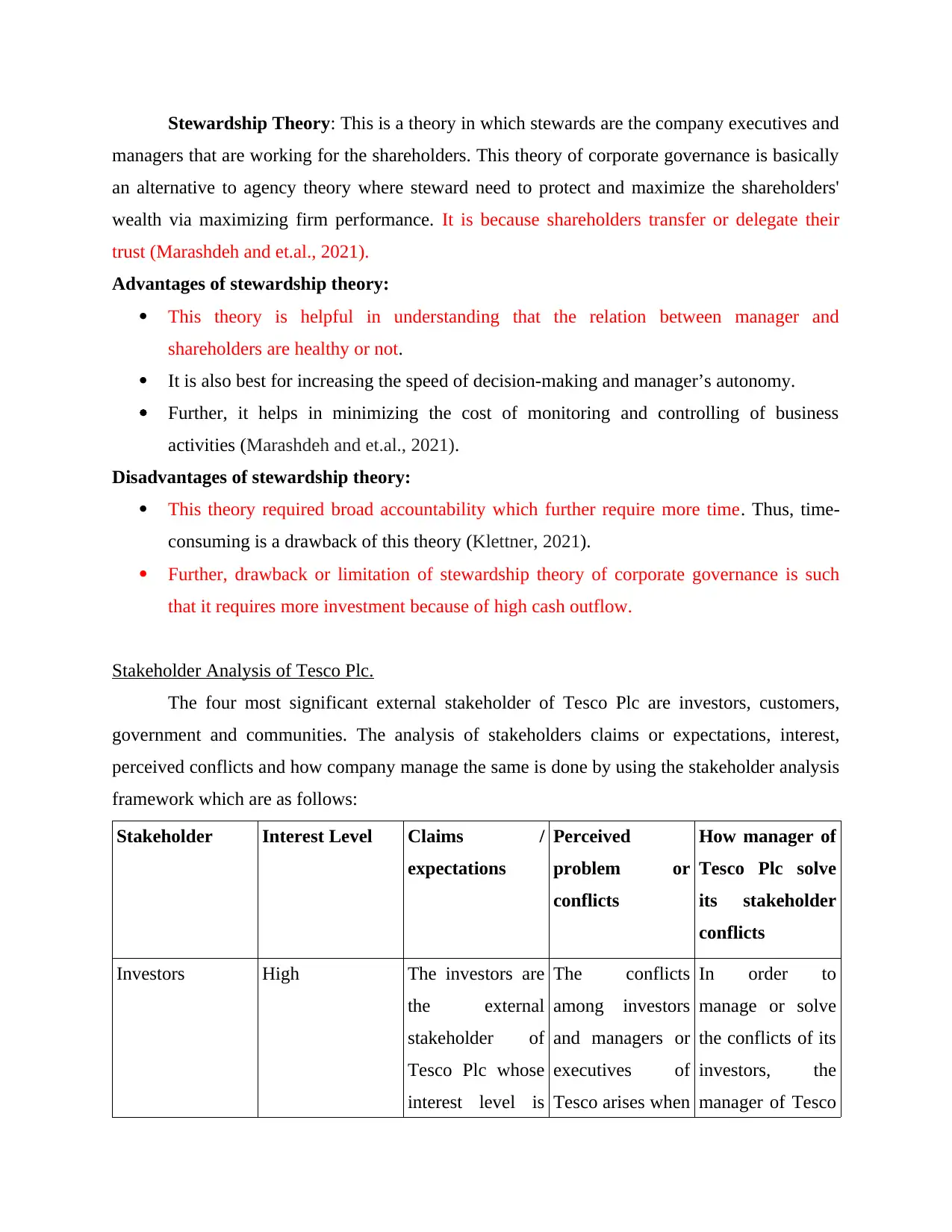
Stewardship Theory: This is a theory in which stewards are the company executives and
managers that are working for the shareholders. This theory of corporate governance is basically
an alternative to agency theory where steward need to protect and maximize the shareholders'
wealth via maximizing firm performance. It is because shareholders transfer or delegate their
trust (Marashdeh and et.al., 2021).
Advantages of stewardship theory:
This theory is helpful in understanding that the relation between manager and
shareholders are healthy or not.
It is also best for increasing the speed of decision-making and manager’s autonomy.
Further, it helps in minimizing the cost of monitoring and controlling of business
activities (Marashdeh and et.al., 2021).
Disadvantages of stewardship theory:
This theory required broad accountability which further require more time. Thus, time-
consuming is a drawback of this theory (Klettner, 2021).
Further, drawback or limitation of stewardship theory of corporate governance is such
that it requires more investment because of high cash outflow.
Stakeholder Analysis of Tesco Plc.
The four most significant external stakeholder of Tesco Plc are investors, customers,
government and communities. The analysis of stakeholders claims or expectations, interest,
perceived conflicts and how company manage the same is done by using the stakeholder analysis
framework which are as follows:
Stakeholder Interest Level Claims /
expectations
Perceived
problem or
conflicts
How manager of
Tesco Plc solve
its stakeholder
conflicts
Investors High The investors are
the external
stakeholder of
Tesco Plc whose
interest level is
The conflicts
among investors
and managers or
executives of
Tesco arises when
In order to
manage or solve
the conflicts of its
investors, the
manager of Tesco
managers that are working for the shareholders. This theory of corporate governance is basically
an alternative to agency theory where steward need to protect and maximize the shareholders'
wealth via maximizing firm performance. It is because shareholders transfer or delegate their
trust (Marashdeh and et.al., 2021).
Advantages of stewardship theory:
This theory is helpful in understanding that the relation between manager and
shareholders are healthy or not.
It is also best for increasing the speed of decision-making and manager’s autonomy.
Further, it helps in minimizing the cost of monitoring and controlling of business
activities (Marashdeh and et.al., 2021).
Disadvantages of stewardship theory:
This theory required broad accountability which further require more time. Thus, time-
consuming is a drawback of this theory (Klettner, 2021).
Further, drawback or limitation of stewardship theory of corporate governance is such
that it requires more investment because of high cash outflow.
Stakeholder Analysis of Tesco Plc.
The four most significant external stakeholder of Tesco Plc are investors, customers,
government and communities. The analysis of stakeholders claims or expectations, interest,
perceived conflicts and how company manage the same is done by using the stakeholder analysis
framework which are as follows:
Stakeholder Interest Level Claims /
expectations
Perceived
problem or
conflicts
How manager of
Tesco Plc solve
its stakeholder
conflicts
Investors High The investors are
the external
stakeholder of
Tesco Plc whose
interest level is
The conflicts
among investors
and managers or
executives of
Tesco arises when
In order to
manage or solve
the conflicts of its
investors, the
manager of Tesco
Secure Best Marks with AI Grader
Need help grading? Try our AI Grader for instant feedback on your assignments.
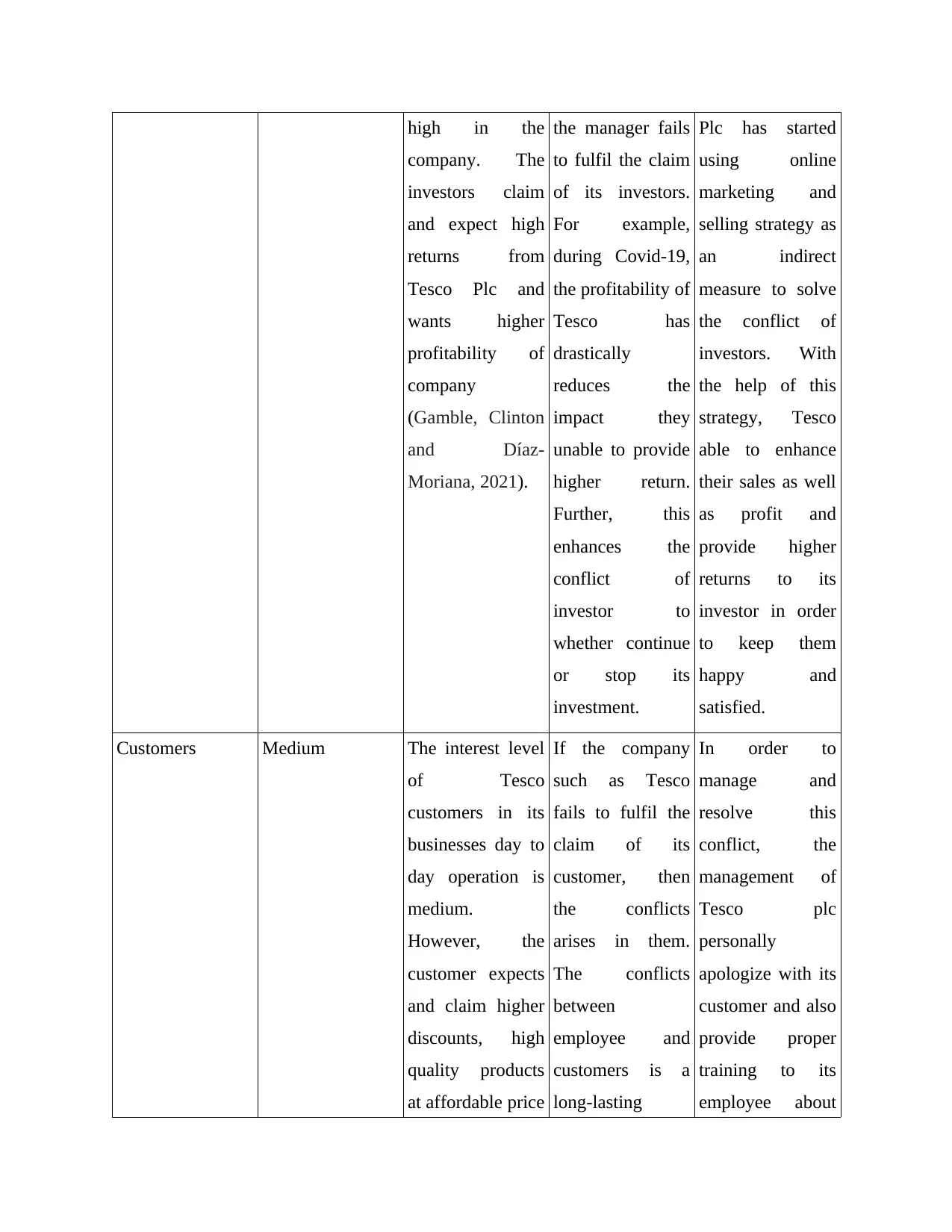
high in the
company. The
investors claim
and expect high
returns from
Tesco Plc and
wants higher
profitability of
company
(Gamble, Clinton
and Díaz-
Moriana, 2021).
the manager fails
to fulfil the claim
of its investors.
For example,
during Covid-19,
the profitability of
Tesco has
drastically
reduces the
impact they
unable to provide
higher return.
Further, this
enhances the
conflict of
investor to
whether continue
or stop its
investment.
Plc has started
using online
marketing and
selling strategy as
an indirect
measure to solve
the conflict of
investors. With
the help of this
strategy, Tesco
able to enhance
their sales as well
as profit and
provide higher
returns to its
investor in order
to keep them
happy and
satisfied.
Customers Medium The interest level
of Tesco
customers in its
businesses day to
day operation is
medium.
However, the
customer expects
and claim higher
discounts, high
quality products
at affordable price
If the company
such as Tesco
fails to fulfil the
claim of its
customer, then
the conflicts
arises in them.
The conflicts
between
employee and
customers is a
long-lasting
In order to
manage and
resolve this
conflict, the
management of
Tesco plc
personally
apologize with its
customer and also
provide proper
training to its
employee about
company. The
investors claim
and expect high
returns from
Tesco Plc and
wants higher
profitability of
company
(Gamble, Clinton
and Díaz-
Moriana, 2021).
the manager fails
to fulfil the claim
of its investors.
For example,
during Covid-19,
the profitability of
Tesco has
drastically
reduces the
impact they
unable to provide
higher return.
Further, this
enhances the
conflict of
investor to
whether continue
or stop its
investment.
Plc has started
using online
marketing and
selling strategy as
an indirect
measure to solve
the conflict of
investors. With
the help of this
strategy, Tesco
able to enhance
their sales as well
as profit and
provide higher
returns to its
investor in order
to keep them
happy and
satisfied.
Customers Medium The interest level
of Tesco
customers in its
businesses day to
day operation is
medium.
However, the
customer expects
and claim higher
discounts, high
quality products
at affordable price
If the company
such as Tesco
fails to fulfil the
claim of its
customer, then
the conflicts
arises in them.
The conflicts
between
employee and
customers is a
long-lasting
In order to
manage and
resolve this
conflict, the
management of
Tesco plc
personally
apologize with its
customer and also
provide proper
training to its
employee about
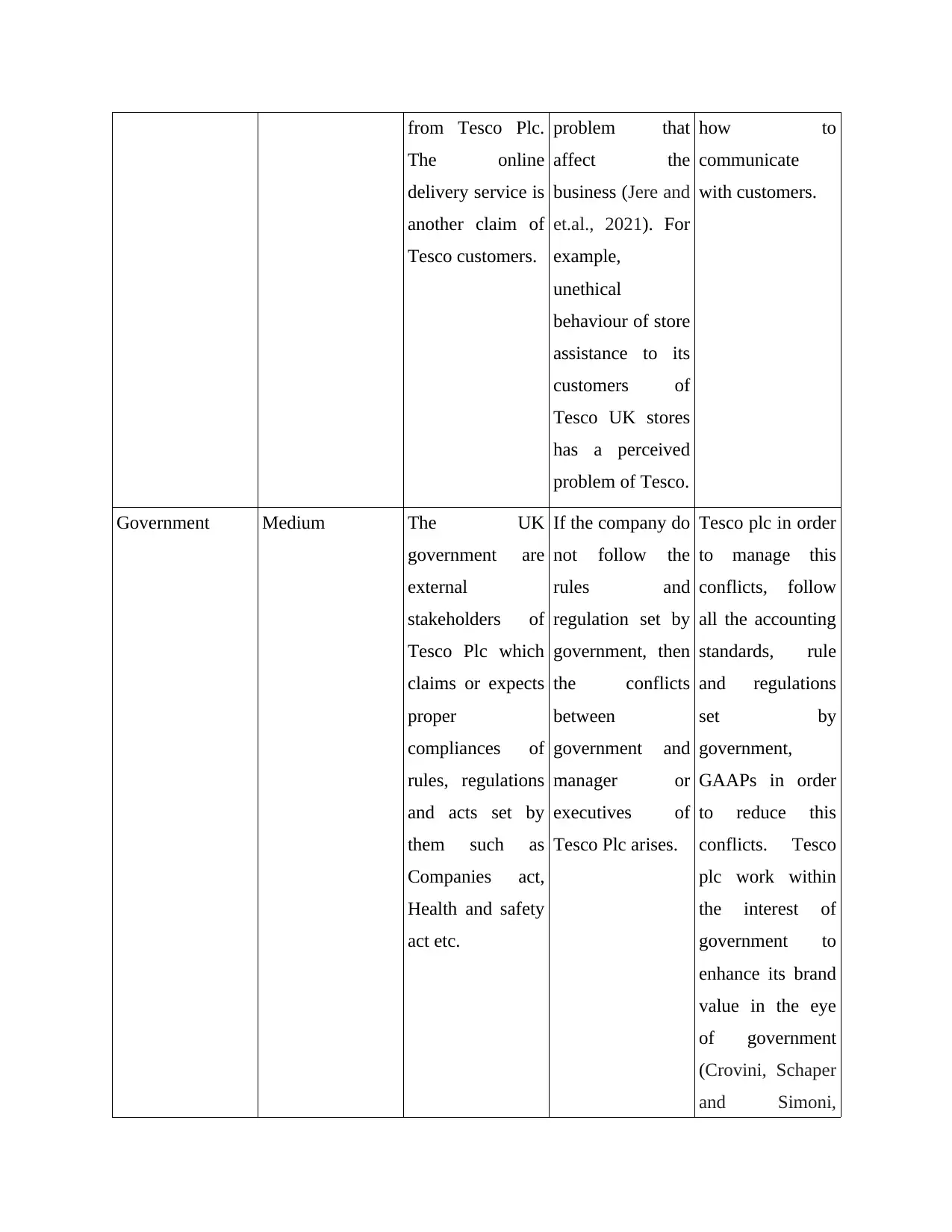
from Tesco Plc.
The online
delivery service is
another claim of
Tesco customers.
problem that
affect the
business (Jere and
et.al., 2021). For
example,
unethical
behaviour of store
assistance to its
customers of
Tesco UK stores
has a perceived
problem of Tesco.
how to
communicate
with customers.
Government Medium The UK
government are
external
stakeholders of
Tesco Plc which
claims or expects
proper
compliances of
rules, regulations
and acts set by
them such as
Companies act,
Health and safety
act etc.
If the company do
not follow the
rules and
regulation set by
government, then
the conflicts
between
government and
manager or
executives of
Tesco Plc arises.
Tesco plc in order
to manage this
conflicts, follow
all the accounting
standards, rule
and regulations
set by
government,
GAAPs in order
to reduce this
conflicts. Tesco
plc work within
the interest of
government to
enhance its brand
value in the eye
of government
(Crovini, Schaper
and Simoni,
The online
delivery service is
another claim of
Tesco customers.
problem that
affect the
business (Jere and
et.al., 2021). For
example,
unethical
behaviour of store
assistance to its
customers of
Tesco UK stores
has a perceived
problem of Tesco.
how to
communicate
with customers.
Government Medium The UK
government are
external
stakeholders of
Tesco Plc which
claims or expects
proper
compliances of
rules, regulations
and acts set by
them such as
Companies act,
Health and safety
act etc.
If the company do
not follow the
rules and
regulation set by
government, then
the conflicts
between
government and
manager or
executives of
Tesco Plc arises.
Tesco plc in order
to manage this
conflicts, follow
all the accounting
standards, rule
and regulations
set by
government,
GAAPs in order
to reduce this
conflicts. Tesco
plc work within
the interest of
government to
enhance its brand
value in the eye
of government
(Crovini, Schaper
and Simoni,

2021).
Local
Communities
High The expectation
and claim of local
communities
from Tesco is that
they carry out the
business in
sustainable
manner without
harming
environment. It is
because the local
community have
high interest in
day to day
operation of
business
(Chkanikova and
Sroufe, 2021).
The concern or
problem of local
community with
the Tesco
manager or
executive is that
whether the kill
animals or not in
order to produce
bags and cloths.
The conflict
between manager
of Tesco and
local community
arises when they
produce do not
adopt sustainable
strategy and do
not donate for
society welfare.
In order to reduce
or avoid this
conflicts, the
management of
Tesco Plc
removes one and
half billions of
plastic and also
banned wet wipes
containing
plastics. Further,
Tesco has also
distributed 82%
of its unsold food
in the UK in meet
the needs of its
community and
society
stakeholder.
Evaluate the board structure of the company
Tesco is the British multinational organization which is leading the market of United Kingdom in
effective as well as efficient manner. The organization is selling retail product and services to the
customers in order to satisfy them in an appropriate manner. The organisation is continuously
generating the profit from domestic as well as international marketplace. The organization
follows the Hierarchical organizational structure which is considered as the organization chain of
command. With the assistance of the organizational structure, the company is able to define the
authority. The board of director of Tesco plc includes five committees such as audit, corporate
social responsibility, nomination, remuneration, and disclosure committees. Furthermore, the
Local
Communities
High The expectation
and claim of local
communities
from Tesco is that
they carry out the
business in
sustainable
manner without
harming
environment. It is
because the local
community have
high interest in
day to day
operation of
business
(Chkanikova and
Sroufe, 2021).
The concern or
problem of local
community with
the Tesco
manager or
executive is that
whether the kill
animals or not in
order to produce
bags and cloths.
The conflict
between manager
of Tesco and
local community
arises when they
produce do not
adopt sustainable
strategy and do
not donate for
society welfare.
In order to reduce
or avoid this
conflicts, the
management of
Tesco Plc
removes one and
half billions of
plastic and also
banned wet wipes
containing
plastics. Further,
Tesco has also
distributed 82%
of its unsold food
in the UK in meet
the needs of its
community and
society
stakeholder.
Evaluate the board structure of the company
Tesco is the British multinational organization which is leading the market of United Kingdom in
effective as well as efficient manner. The organization is selling retail product and services to the
customers in order to satisfy them in an appropriate manner. The organisation is continuously
generating the profit from domestic as well as international marketplace. The organization
follows the Hierarchical organizational structure which is considered as the organization chain of
command. With the assistance of the organizational structure, the company is able to define the
authority. The board of director of Tesco plc includes five committees such as audit, corporate
social responsibility, nomination, remuneration, and disclosure committees. Furthermore, the
Paraphrase This Document
Need a fresh take? Get an instant paraphrase of this document with our AI Paraphraser

board of director is consisted of the 10 members in the Tesco plc. With the assistance of the
hierarchical structure the management clarify the role and responsibility to the people in the
effective as well as efficient manner (Zaman, and et.al 2022). Furthermore, it provides help in
representing different manager’s duty and responsible personality in adequate manner. For
instance, the members of the Tesco are represented into four management layers which consist
of different manger as per their department such as regional, store, food trading, non- food,
personnel, fresh food section, ambient food section, electrical section, clothing section manager
etc. This structure is largely followed by the multinational organization.
In this organizational structure the manager of Tesco company is able to allocate the resources,
rewards, offer and bonuses to the workers of the organization. Due to the structure the employees
are able to report the right and responsible person of the company. The structure of the
organization connects the workers, stakeholders and multiple workers with the company vision
and mission. Moreover, it will be easy for the workers to clarify the career path and give
opportunity to make decision on the behalf of the organization. Basically, it is the process of
empowering the employees or the working personality of the organizations individually
(Greuning, and Brajovic-Bratanovic S 2022). Due to the structure of the company the members
of the Tesco enjoy the flexibility of supply chain and worked in the coordination with the proper
alignment of resources in particular time period. The members of the Tesco which is listed in the
organizational structure make sure that the work will be done as per the aim and objective of the
organization. In context to that the manager of the organization performs the function effectively
and efficiently. Along with that, it maximizes the working condition with different responsibility.
Due to this organizational structure, the management of the company such as Tesco able to
deliver information of the assets as soon it will be purchased by company. Also, it is one of the
best structure that has bring coordination and cooperation among the people working in Tesco
company. Moreover, the higher authority under this hierarchy structure collects the daily update
from the subordinate in order to increase the productivity and profitability of the company. This
structure of the company plays essential role in the controlling and managing the function of the
enterprises. It also delivers competitive advantages in the marketplace.
Institutional investors of the company
The institutional investor refers to the company or the enterprises that invest the money in the
marketplace on the behalf of the public. The mutual fund, pension. Hedge funds and endowment
hierarchical structure the management clarify the role and responsibility to the people in the
effective as well as efficient manner (Zaman, and et.al 2022). Furthermore, it provides help in
representing different manager’s duty and responsible personality in adequate manner. For
instance, the members of the Tesco are represented into four management layers which consist
of different manger as per their department such as regional, store, food trading, non- food,
personnel, fresh food section, ambient food section, electrical section, clothing section manager
etc. This structure is largely followed by the multinational organization.
In this organizational structure the manager of Tesco company is able to allocate the resources,
rewards, offer and bonuses to the workers of the organization. Due to the structure the employees
are able to report the right and responsible person of the company. The structure of the
organization connects the workers, stakeholders and multiple workers with the company vision
and mission. Moreover, it will be easy for the workers to clarify the career path and give
opportunity to make decision on the behalf of the organization. Basically, it is the process of
empowering the employees or the working personality of the organizations individually
(Greuning, and Brajovic-Bratanovic S 2022). Due to the structure of the company the members
of the Tesco enjoy the flexibility of supply chain and worked in the coordination with the proper
alignment of resources in particular time period. The members of the Tesco which is listed in the
organizational structure make sure that the work will be done as per the aim and objective of the
organization. In context to that the manager of the organization performs the function effectively
and efficiently. Along with that, it maximizes the working condition with different responsibility.
Due to this organizational structure, the management of the company such as Tesco able to
deliver information of the assets as soon it will be purchased by company. Also, it is one of the
best structure that has bring coordination and cooperation among the people working in Tesco
company. Moreover, the higher authority under this hierarchy structure collects the daily update
from the subordinate in order to increase the productivity and profitability of the company. This
structure of the company plays essential role in the controlling and managing the function of the
enterprises. It also delivers competitive advantages in the marketplace.
Institutional investors of the company
The institutional investor refers to the company or the enterprises that invest the money in the
marketplace on the behalf of the public. The mutual fund, pension. Hedge funds and endowment
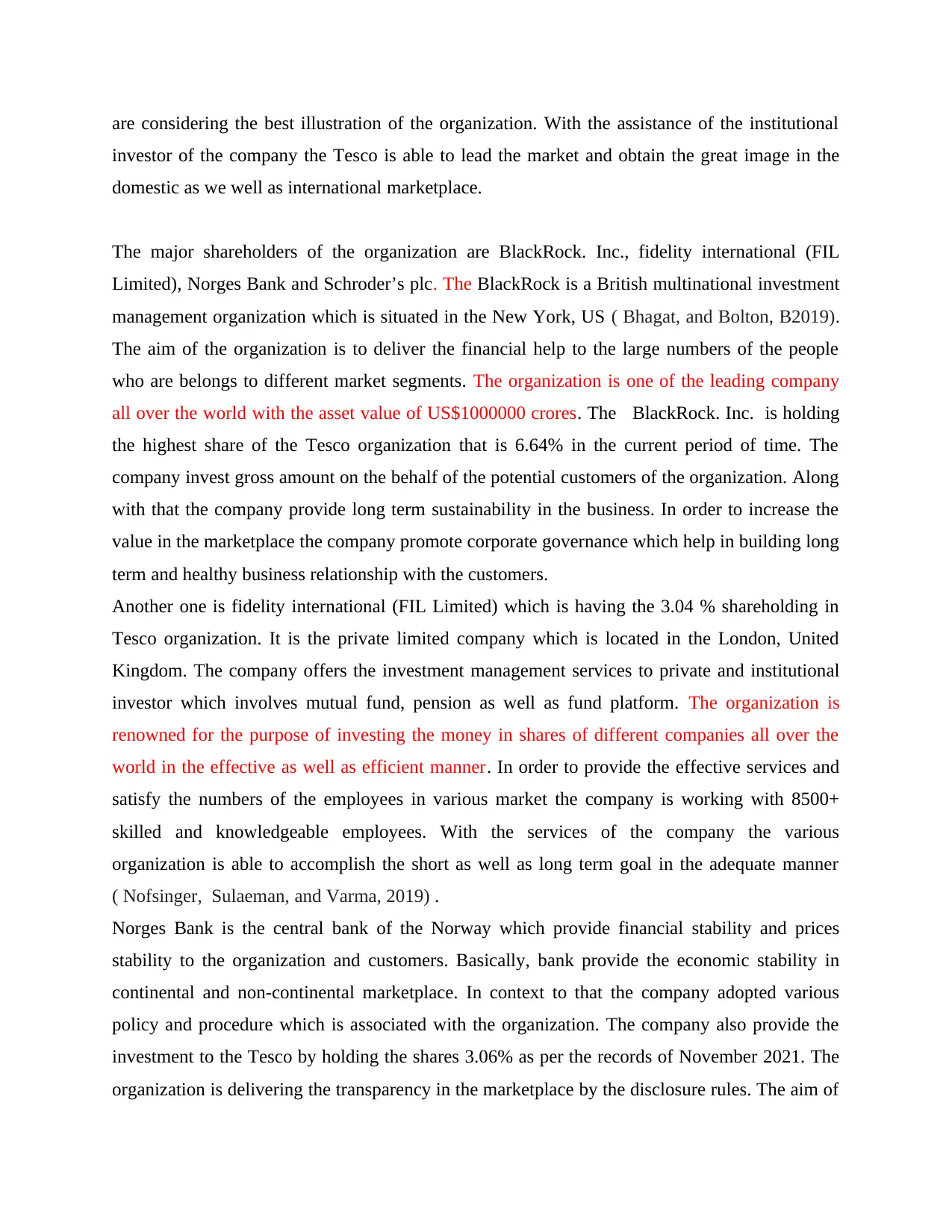
are considering the best illustration of the organization. With the assistance of the institutional
investor of the company the Tesco is able to lead the market and obtain the great image in the
domestic as we well as international marketplace.
The major shareholders of the organization are BlackRock. Inc., fidelity international (FIL
Limited), Norges Bank and Schroder’s plc. The BlackRock is a British multinational investment
management organization which is situated in the New York, US ( Bhagat, and Bolton, B2019).
The aim of the organization is to deliver the financial help to the large numbers of the people
who are belongs to different market segments. The organization is one of the leading company
all over the world with the asset value of US$1000000 crores. The BlackRock. Inc. is holding
the highest share of the Tesco organization that is 6.64% in the current period of time. The
company invest gross amount on the behalf of the potential customers of the organization. Along
with that the company provide long term sustainability in the business. In order to increase the
value in the marketplace the company promote corporate governance which help in building long
term and healthy business relationship with the customers.
Another one is fidelity international (FIL Limited) which is having the 3.04 % shareholding in
Tesco organization. It is the private limited company which is located in the London, United
Kingdom. The company offers the investment management services to private and institutional
investor which involves mutual fund, pension as well as fund platform. The organization is
renowned for the purpose of investing the money in shares of different companies all over the
world in the effective as well as efficient manner. In order to provide the effective services and
satisfy the numbers of the employees in various market the company is working with 8500+
skilled and knowledgeable employees. With the services of the company the various
organization is able to accomplish the short as well as long term goal in the adequate manner
( Nofsinger, Sulaeman, and Varma, 2019) .
Norges Bank is the central bank of the Norway which provide financial stability and prices
stability to the organization and customers. Basically, bank provide the economic stability in
continental and non-continental marketplace. In context to that the company adopted various
policy and procedure which is associated with the organization. The company also provide the
investment to the Tesco by holding the shares 3.06% as per the records of November 2021. The
organization is delivering the transparency in the marketplace by the disclosure rules. The aim of
investor of the company the Tesco is able to lead the market and obtain the great image in the
domestic as we well as international marketplace.
The major shareholders of the organization are BlackRock. Inc., fidelity international (FIL
Limited), Norges Bank and Schroder’s plc. The BlackRock is a British multinational investment
management organization which is situated in the New York, US ( Bhagat, and Bolton, B2019).
The aim of the organization is to deliver the financial help to the large numbers of the people
who are belongs to different market segments. The organization is one of the leading company
all over the world with the asset value of US$1000000 crores. The BlackRock. Inc. is holding
the highest share of the Tesco organization that is 6.64% in the current period of time. The
company invest gross amount on the behalf of the potential customers of the organization. Along
with that the company provide long term sustainability in the business. In order to increase the
value in the marketplace the company promote corporate governance which help in building long
term and healthy business relationship with the customers.
Another one is fidelity international (FIL Limited) which is having the 3.04 % shareholding in
Tesco organization. It is the private limited company which is located in the London, United
Kingdom. The company offers the investment management services to private and institutional
investor which involves mutual fund, pension as well as fund platform. The organization is
renowned for the purpose of investing the money in shares of different companies all over the
world in the effective as well as efficient manner. In order to provide the effective services and
satisfy the numbers of the employees in various market the company is working with 8500+
skilled and knowledgeable employees. With the services of the company the various
organization is able to accomplish the short as well as long term goal in the adequate manner
( Nofsinger, Sulaeman, and Varma, 2019) .
Norges Bank is the central bank of the Norway which provide financial stability and prices
stability to the organization and customers. Basically, bank provide the economic stability in
continental and non-continental marketplace. In context to that the company adopted various
policy and procedure which is associated with the organization. The company also provide the
investment to the Tesco by holding the shares 3.06% as per the records of November 2021. The
organization is delivering the transparency in the marketplace by the disclosure rules. The aim of
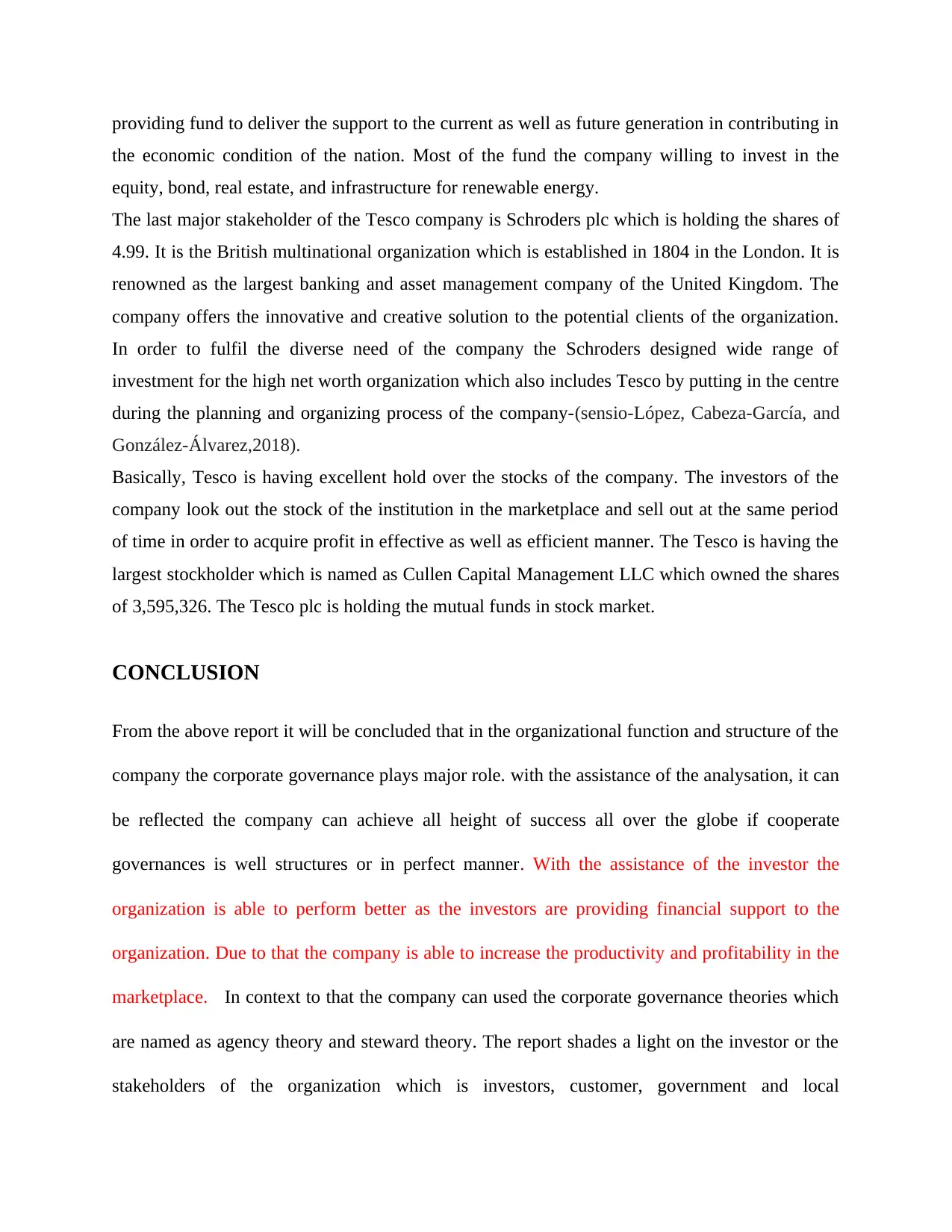
providing fund to deliver the support to the current as well as future generation in contributing in
the economic condition of the nation. Most of the fund the company willing to invest in the
equity, bond, real estate, and infrastructure for renewable energy.
The last major stakeholder of the Tesco company is Schroders plc which is holding the shares of
4.99. It is the British multinational organization which is established in 1804 in the London. It is
renowned as the largest banking and asset management company of the United Kingdom. The
company offers the innovative and creative solution to the potential clients of the organization.
In order to fulfil the diverse need of the company the Schroders designed wide range of
investment for the high net worth organization which also includes Tesco by putting in the centre
during the planning and organizing process of the company-(sensio-López, Cabeza-García, and
González-Álvarez,2018).
Basically, Tesco is having excellent hold over the stocks of the company. The investors of the
company look out the stock of the institution in the marketplace and sell out at the same period
of time in order to acquire profit in effective as well as efficient manner. The Tesco is having the
largest stockholder which is named as Cullen Capital Management LLC which owned the shares
of 3,595,326. The Tesco plc is holding the mutual funds in stock market.
CONCLUSION
From the above report it will be concluded that in the organizational function and structure of the
company the corporate governance plays major role. with the assistance of the analysation, it can
be reflected the company can achieve all height of success all over the globe if cooperate
governances is well structures or in perfect manner. With the assistance of the investor the
organization is able to perform better as the investors are providing financial support to the
organization. Due to that the company is able to increase the productivity and profitability in the
marketplace. In context to that the company can used the corporate governance theories which
are named as agency theory and steward theory. The report shades a light on the investor or the
stakeholders of the organization which is investors, customer, government and local
the economic condition of the nation. Most of the fund the company willing to invest in the
equity, bond, real estate, and infrastructure for renewable energy.
The last major stakeholder of the Tesco company is Schroders plc which is holding the shares of
4.99. It is the British multinational organization which is established in 1804 in the London. It is
renowned as the largest banking and asset management company of the United Kingdom. The
company offers the innovative and creative solution to the potential clients of the organization.
In order to fulfil the diverse need of the company the Schroders designed wide range of
investment for the high net worth organization which also includes Tesco by putting in the centre
during the planning and organizing process of the company-(sensio-López, Cabeza-García, and
González-Álvarez,2018).
Basically, Tesco is having excellent hold over the stocks of the company. The investors of the
company look out the stock of the institution in the marketplace and sell out at the same period
of time in order to acquire profit in effective as well as efficient manner. The Tesco is having the
largest stockholder which is named as Cullen Capital Management LLC which owned the shares
of 3,595,326. The Tesco plc is holding the mutual funds in stock market.
CONCLUSION
From the above report it will be concluded that in the organizational function and structure of the
company the corporate governance plays major role. with the assistance of the analysation, it can
be reflected the company can achieve all height of success all over the globe if cooperate
governances is well structures or in perfect manner. With the assistance of the investor the
organization is able to perform better as the investors are providing financial support to the
organization. Due to that the company is able to increase the productivity and profitability in the
marketplace. In context to that the company can used the corporate governance theories which
are named as agency theory and steward theory. The report shades a light on the investor or the
stakeholders of the organization which is investors, customer, government and local
Secure Best Marks with AI Grader
Need help grading? Try our AI Grader for instant feedback on your assignments.
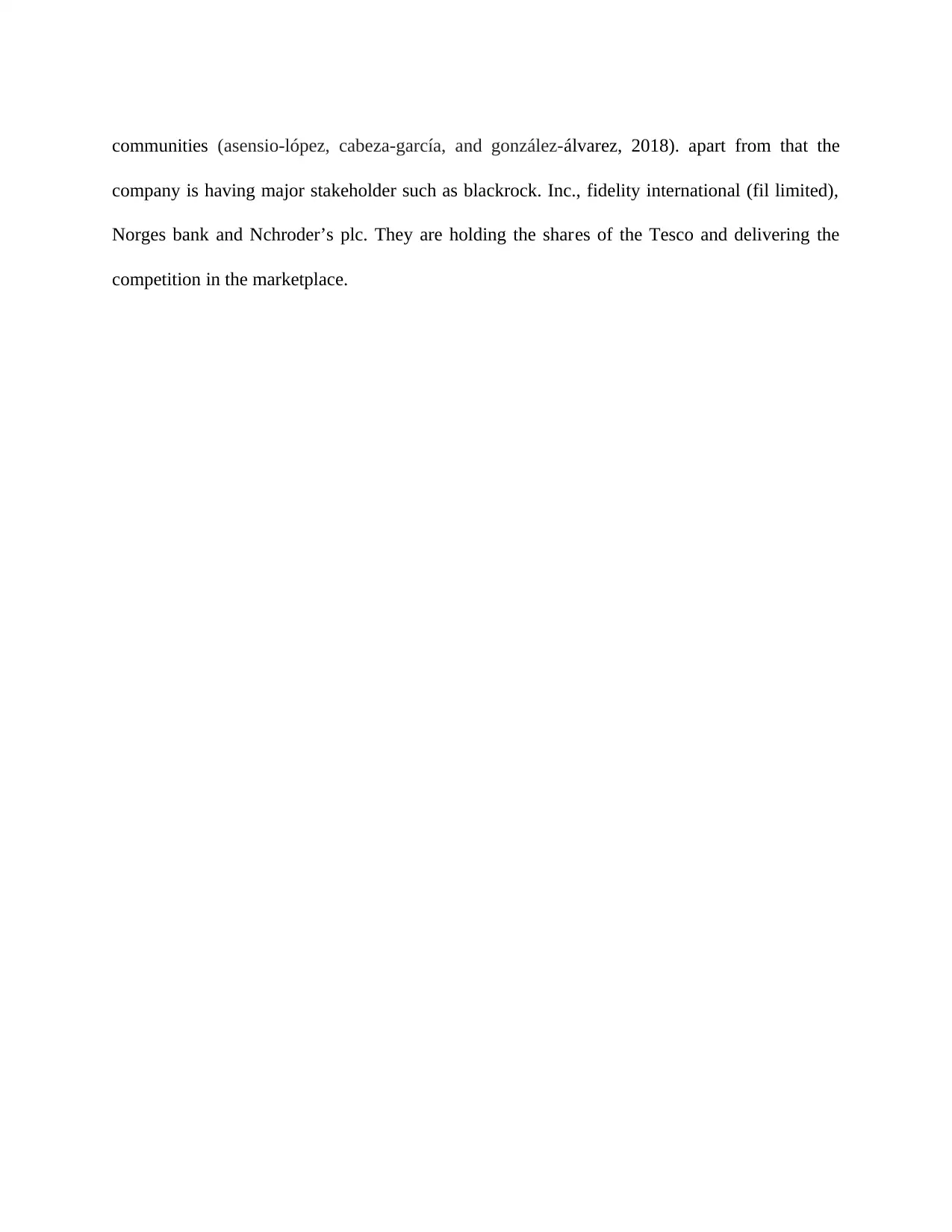
communities (asensio-lópez, cabeza-garcía, and gonzález-álvarez, 2018). apart from that the
company is having major stakeholder such as blackrock. Inc., fidelity international (fil limited),
Norges bank and Nchroder’s plc. They are holding the shares of the Tesco and delivering the
competition in the marketplace.
company is having major stakeholder such as blackrock. Inc., fidelity international (fil limited),
Norges bank and Nchroder’s plc. They are holding the shares of the Tesco and delivering the
competition in the marketplace.
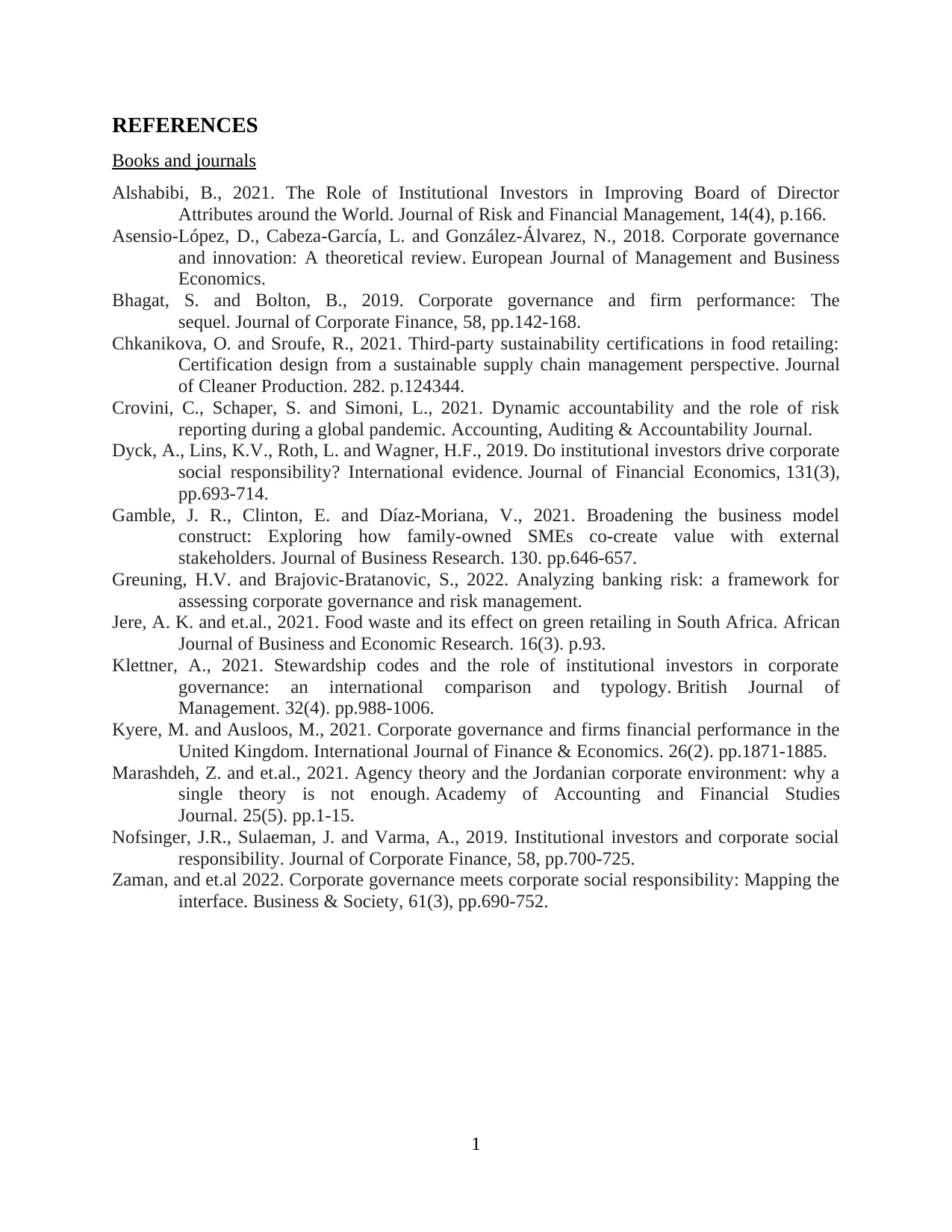
REFERENCES
Books and journals
Alshabibi, B., 2021. The Role of Institutional Investors in Improving Board of Director
Attributes around the World. Journal of Risk and Financial Management, 14(4), p.166.
Asensio-López, D., Cabeza-García, L. and González-Álvarez, N., 2018. Corporate governance
and innovation: A theoretical review. European Journal of Management and Business
Economics.
Bhagat, S. and Bolton, B., 2019. Corporate governance and firm performance: The
sequel. Journal of Corporate Finance, 58, pp.142-168.
Chkanikova, O. and Sroufe, R., 2021. Third-party sustainability certifications in food retailing:
Certification design from a sustainable supply chain management perspective. Journal
of Cleaner Production. 282. p.124344.
Crovini, C., Schaper, S. and Simoni, L., 2021. Dynamic accountability and the role of risk
reporting during a global pandemic. Accounting, Auditing & Accountability Journal.
Dyck, A., Lins, K.V., Roth, L. and Wagner, H.F., 2019. Do institutional investors drive corporate
social responsibility? International evidence. Journal of Financial Economics, 131(3),
pp.693-714.
Gamble, J. R., Clinton, E. and Díaz-Moriana, V., 2021. Broadening the business model
construct: Exploring how family-owned SMEs co-create value with external
stakeholders. Journal of Business Research. 130. pp.646-657.
Greuning, H.V. and Brajovic-Bratanovic, S., 2022. Analyzing banking risk: a framework for
assessing corporate governance and risk management.
Jere, A. K. and et.al., 2021. Food waste and its effect on green retailing in South Africa. African
Journal of Business and Economic Research. 16(3). p.93.
Klettner, A., 2021. Stewardship codes and the role of institutional investors in corporate
governance: an international comparison and typology. British Journal of
Management. 32(4). pp.988-1006.
Kyere, M. and Ausloos, M., 2021. Corporate governance and firms financial performance in the
United Kingdom. International Journal of Finance & Economics. 26(2). pp.1871-1885.
Marashdeh, Z. and et.al., 2021. Agency theory and the Jordanian corporate environment: why a
single theory is not enough. Academy of Accounting and Financial Studies
Journal. 25(5). pp.1-15.
Nofsinger, J.R., Sulaeman, J. and Varma, A., 2019. Institutional investors and corporate social
responsibility. Journal of Corporate Finance, 58, pp.700-725.
Zaman, and et.al 2022. Corporate governance meets corporate social responsibility: Mapping the
interface. Business & Society, 61(3), pp.690-752.
1
Books and journals
Alshabibi, B., 2021. The Role of Institutional Investors in Improving Board of Director
Attributes around the World. Journal of Risk and Financial Management, 14(4), p.166.
Asensio-López, D., Cabeza-García, L. and González-Álvarez, N., 2018. Corporate governance
and innovation: A theoretical review. European Journal of Management and Business
Economics.
Bhagat, S. and Bolton, B., 2019. Corporate governance and firm performance: The
sequel. Journal of Corporate Finance, 58, pp.142-168.
Chkanikova, O. and Sroufe, R., 2021. Third-party sustainability certifications in food retailing:
Certification design from a sustainable supply chain management perspective. Journal
of Cleaner Production. 282. p.124344.
Crovini, C., Schaper, S. and Simoni, L., 2021. Dynamic accountability and the role of risk
reporting during a global pandemic. Accounting, Auditing & Accountability Journal.
Dyck, A., Lins, K.V., Roth, L. and Wagner, H.F., 2019. Do institutional investors drive corporate
social responsibility? International evidence. Journal of Financial Economics, 131(3),
pp.693-714.
Gamble, J. R., Clinton, E. and Díaz-Moriana, V., 2021. Broadening the business model
construct: Exploring how family-owned SMEs co-create value with external
stakeholders. Journal of Business Research. 130. pp.646-657.
Greuning, H.V. and Brajovic-Bratanovic, S., 2022. Analyzing banking risk: a framework for
assessing corporate governance and risk management.
Jere, A. K. and et.al., 2021. Food waste and its effect on green retailing in South Africa. African
Journal of Business and Economic Research. 16(3). p.93.
Klettner, A., 2021. Stewardship codes and the role of institutional investors in corporate
governance: an international comparison and typology. British Journal of
Management. 32(4). pp.988-1006.
Kyere, M. and Ausloos, M., 2021. Corporate governance and firms financial performance in the
United Kingdom. International Journal of Finance & Economics. 26(2). pp.1871-1885.
Marashdeh, Z. and et.al., 2021. Agency theory and the Jordanian corporate environment: why a
single theory is not enough. Academy of Accounting and Financial Studies
Journal. 25(5). pp.1-15.
Nofsinger, J.R., Sulaeman, J. and Varma, A., 2019. Institutional investors and corporate social
responsibility. Journal of Corporate Finance, 58, pp.700-725.
Zaman, and et.al 2022. Corporate governance meets corporate social responsibility: Mapping the
interface. Business & Society, 61(3), pp.690-752.
1
1 out of 12
Related Documents
Your All-in-One AI-Powered Toolkit for Academic Success.
+13062052269
info@desklib.com
Available 24*7 on WhatsApp / Email
![[object Object]](/_next/static/media/star-bottom.7253800d.svg)
Unlock your academic potential
© 2024 | Zucol Services PVT LTD | All rights reserved.





